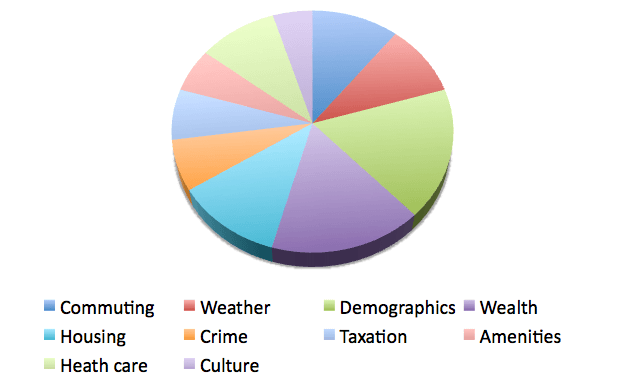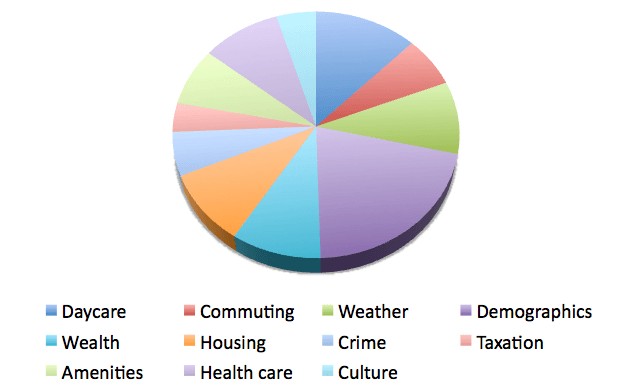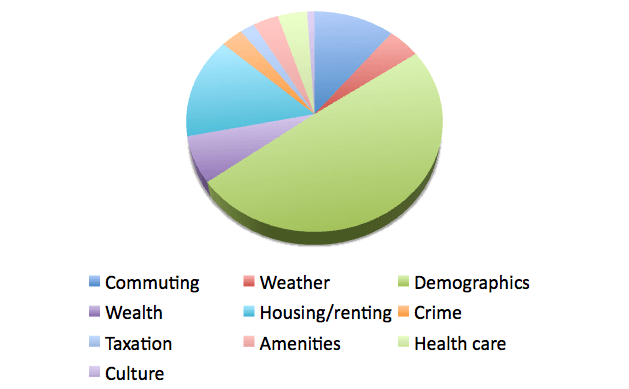Canada’s Best Places to Live 2013 Methodology
See how we crunched the numbers to determine Canada's Best Places to Live 2013.
Advertisement
See how we crunched the numbers to determine Canada's Best Places to Live 2013.
 New this year
This year we ranked each city against its peers and overall. A small city is defined by a population below 100,000, a mid-size city has population of between 100,000 and 400,000 and a large city has a minimum population of 400,000.
Eleven new categories were added to help us come up with our ranking. To accommodate the new categories we have updated our scoring system. Some categories like weather for instance, now have a smaller weighting in our ranking than in previous years, while other categories have been expanded. Categories new to our list this year include: household net worth, the number of days of precipitation, the number of days where the temperature is above 20 degrees C, the five-year change in crime rate, property tax measures, movie theatres and whether a city is within close proximity to an airport serviced by Air Canada or WestJet.
Ten cities are also new to our list this year. They include: Langley, B.C., Boucherville, Que., North Vancouver, B.C., West Vancouver, B.C., Châteauguay, Que., Saint-Eustache, Que., Mascouche, Que. Georgina, Ont. Haldimand County, Ont. and Mirabel, Que.
In addition to our highly popular Best Places to Live, Best Places to Raise Kids and Best Places to Retire lists, we’ve added Best Places for New Immigrants. This list rewards communities that already have a strong immigrant population, employment opportunities, reasonable rental rates and apartment vacancies, considerations for any person looking to call Canada home. A full breakdown of our methodology is below.
And while MoneySense strongly believes air quality is an important variable in determining the quality of life within a city, we unfortunately had to drop this category from our ranking system because we were unable to find reliable and current data for each city.
The calculations
A total of 103 points was up for grabs. Each category (below) was allotted a number of points depending on the importance of the category. For example, employment statistics are worth 10 points while sales taxes are worth 1 point. Some categories are further broken into subcategories. For example, the crime category is determined by statistics in the subcategories of violent crime, crime severity and total crime.
The top city in each category received the maximum number of points, and the rest of the cities received descending incremental points based on their ranking.
For example, in the area of unemployment, Canmore, Alta., had the lowest unemployment rate in the country (2.3%). It was ranked No. 1 in that category and received 10 points. The second-best city in the unemployment category, High River, Alta., received 9.95 points. The next city was Boucherville, Que. with 9.90 points and so on, down to the 200th city (Bay Roberts, N.L. with an unemployment rate of 22.4%), which received no points.
Calculations for some other categories follow a slightly different methodology. For example, in the category of population growth, an annual rate of 6.56% was considered ideal. Anything below or above that rate loses points and cities with a population loss receive zero. The same is true for the subcategory of precipitation, which makes up part of the weather category. (The ideal number is 700 mm a year, with anything above or below that level losing points accordingly.) As well, 5 points were awarded on the percentage of people employed in arts, culture, recreation and sports.
Here’s an example of how the scoring system works:
New this year
This year we ranked each city against its peers and overall. A small city is defined by a population below 100,000, a mid-size city has population of between 100,000 and 400,000 and a large city has a minimum population of 400,000.
Eleven new categories were added to help us come up with our ranking. To accommodate the new categories we have updated our scoring system. Some categories like weather for instance, now have a smaller weighting in our ranking than in previous years, while other categories have been expanded. Categories new to our list this year include: household net worth, the number of days of precipitation, the number of days where the temperature is above 20 degrees C, the five-year change in crime rate, property tax measures, movie theatres and whether a city is within close proximity to an airport serviced by Air Canada or WestJet.
Ten cities are also new to our list this year. They include: Langley, B.C., Boucherville, Que., North Vancouver, B.C., West Vancouver, B.C., Châteauguay, Que., Saint-Eustache, Que., Mascouche, Que. Georgina, Ont. Haldimand County, Ont. and Mirabel, Que.
In addition to our highly popular Best Places to Live, Best Places to Raise Kids and Best Places to Retire lists, we’ve added Best Places for New Immigrants. This list rewards communities that already have a strong immigrant population, employment opportunities, reasonable rental rates and apartment vacancies, considerations for any person looking to call Canada home. A full breakdown of our methodology is below.
And while MoneySense strongly believes air quality is an important variable in determining the quality of life within a city, we unfortunately had to drop this category from our ranking system because we were unable to find reliable and current data for each city.
The calculations
A total of 103 points was up for grabs. Each category (below) was allotted a number of points depending on the importance of the category. For example, employment statistics are worth 10 points while sales taxes are worth 1 point. Some categories are further broken into subcategories. For example, the crime category is determined by statistics in the subcategories of violent crime, crime severity and total crime.
The top city in each category received the maximum number of points, and the rest of the cities received descending incremental points based on their ranking.
For example, in the area of unemployment, Canmore, Alta., had the lowest unemployment rate in the country (2.3%). It was ranked No. 1 in that category and received 10 points. The second-best city in the unemployment category, High River, Alta., received 9.95 points. The next city was Boucherville, Que. with 9.90 points and so on, down to the 200th city (Bay Roberts, N.L. with an unemployment rate of 22.4%), which received no points.
Calculations for some other categories follow a slightly different methodology. For example, in the category of population growth, an annual rate of 6.56% was considered ideal. Anything below or above that rate loses points and cities with a population loss receive zero. The same is true for the subcategory of precipitation, which makes up part of the weather category. (The ideal number is 700 mm a year, with anything above or below that level losing points accordingly.) As well, 5 points were awarded on the percentage of people employed in arts, culture, recreation and sports.
Here’s an example of how the scoring system works:
| Yellowknife, N.W.T. | ||||
| Travel to Work by Bicycle % | Travel to Work by Walking % | Travel to Work by Public Transit % | Labour Force Unemployment Rate Score | |
| Points earned | 2.83 | 2.95 | 1.83 | 5.63 |
| Avail. points | 3.00 | 3.00 | 5.00 | 10.00 |
| Annual Rain Fall (mm) | Number of Days with Rain | % of Days with Precipitation (Rain or Snow) | Number of Days w/ min. Temp Above 0C Score | Number of Days w/ min. Temp Above 20C Score |
| 0.20 | 3.00 | 0.87 | 0.03 | 0.03 |
| 2.00 | 3.00 | 1.00 | 3.00 | 1.00 |
| Average Value of Primary Real Estate Score | Average Time to Buy a Home Rank | Average Household Income Score | Average Household Discretionary Income Score | Average Household Net Worth Score |
| 0.78 | 2.95 | 4.87 | 4.87 | 2.49 |
| 6.00 | 6.00 | 5.00 | 5.00 | 5.00 |
| % change in Population ’11 to ’12 Score | 5 year Change in Crime Rate per 100,000 Score | Violent Crime Rate per 100,000 Score | Crime per 100,000 Score | CSI Score |
| 7.56 | 0.07 | 0.05 | 0.02 | 0.02 |
| 8.00 | 1.00 | 2.00 | 2.00 | 2.00 |
| Total Sales Taxes Score | Income Tax on $50,000 Score | Property Tax (%) Score | Average Property tax as a % of Household Income Score | % New Cars 2010 Model Year and Up Score |
| 1.00 | 2.70 | 0.65 | 0.34 | 1.36 |
| 1.00 | 3.00 | 2.00 | 1.00 | 2.00 |
| Doctors per ‘000 Score | % Employed in Health Care Sector Score | Number of Doctors of Medicine Offices per ‘000 Score | % Employed in Art, Culture, Recreation, Sport score | Hospital |
| 3.99 | 2.55 | 0.08 | 4.80 | 2 |
| 5.00 | 4.00 | 1.00 | 5.00 | 2 |
| College | University | Movie Theatre | Prox. to Major Airport | FINAL |
| 1 | 0 | 0.5 | 1.5 | 63.57 |
| 1 | 1 | 0.5 | 1.5 | 103.00 |

| WEATHER | 20 |
| PROPERTY TAX | 6 |
| SALES TAX | 1 |
| INCOME TAXES | 3 |
| CULTURE | 5 |
| CRIME | 7 |
| HEALTH CARE | 16 |
| TRANSIT | 5 |
| HOSPITAL | 4 |
| WALK/RIDE | 6 |
| PROXIMITY TO AN AIRPORT | 2 |
| NEW CAR | 1 |
| THEATRE | 1 |
| POPULATION GROWTH | 8 |
| NET WORTH | 5 |
| HOUSING | 10 |
| TOTAL | 100 |
| WALK/RIDE TO WORK | 6 |
| TRANSIT | 5 |
| WEATHER | 4.5 |
| POPULATION GROWTH | 2 |
| UNEMPLOYMENT | 8 |
| HOUSING | 4 |
| HOUSEHOLD INCOME | 3 |
| DISCRETIONARY INCOME | 2 |
| HOUSEHOLD NET WORTH | 2 |
| CRIME | 3 |
| SALES TAXES | 1 |
| INCOME TAXES | 1 |
| DOCTORS PER 1,000 | 2 |
| HEALTH PROFSESIONARL | 1 |
| DOC OFF | 1 |
| UNIVERSITY | 0.5 |
| COLLEGE | 0.5 |
| CULTURE | 1 |
| PROXIMITY TO AN AIRPORT | 1.5 |
| LANGUAGE DIVERSITY | 10 |
| IMMIGRATION POPULULATION | 30 |
| AFFORDABLE RENT (1-BEDROOM APPARTMENT) | 5 |
| RENTAL VACANCIES | 5 |
| TOTAL | 101 |

Share this article Share on Facebook Share on Twitter Share on Linkedin Share on Reddit Share on Email